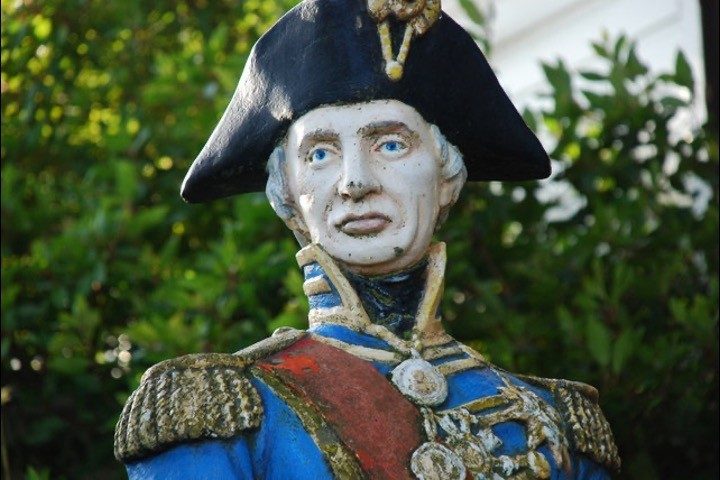
Imagine you invite a couple of people to stay at your home, which has been in your family for generations. Now imagine that because they find pictures of great-grandpa and some other ancestors adorning your walls offensive, a few of your family members consider destroying the works.
How would you describe those family members’ mentality? Self-image problem? Lack of self-respect? A desire for approval overwhelming enough to make one prostrate himself before others?
Whatever you call it, this is precisely what’s happening in the Welsh national family. In fact, states new government guidance in Wales, statues of “‘old white men’ such as the Duke of Wellington and Admiral Lord Nelson could be hidden or destroyed to create the ‘right historical narrative,’” related The Telegraph Saturday.
The paper continued:
Historical statues that often glorify “powerful, older, able-bodied white men” may be “offensive” to a more diverse modern public, according to guidance which is expected to be finalised this month.
The government’s “best-practice” advice states that councils and other public bodies should “take action” to set the “right historical narrative”.
It says authorities could “conceal commemorations” and “discretely box monuments or enclose them creatively in new artworks”.
Street and buildings could also be changed, the guidance states, to “remove offensive or unwanted names”.
Alternatively, “offensive or unwanted items” could be relocated or destroyed, the advisory documents state, while noting drawbacks including expense and the need for extensive public consultation.
Public commemorations including paintings, plaques and statues, the advice states, should “not insult or hurt fellow citizens”.
Why the government would need “extensive public consultation” to destroy these items when it apparently doesn’t require it to remove them is not explained. Presumably, though, going full Taliban with summary execution is an act revolutionary enough to rouse slumbering masses; wiser may be an evolutionary approach to this cultural devolution, ushering the victim away and hiding him somewhere until, when he’s mostly forgotten, he can be quietly disposed of.
If thus anthropomorphizing an object seems odd, note that The Telegraph just informed us that a statue can “offend,” “insult,” or “hurt” citizens.
“Hello, police? I want to file hate-speech charges against Admiral Lord Nelson!”
Police: “Lord Nelson? He’s … he’s dead.”
Caller: “I mean, the Nelson statue. I passed him just minutes ago in Llanfairpwll, and the &#%!@?! hurled a racial epithet at me!”
Then there’s this warning: “Watch out for those old white guy statues! Turn around and they’ll jump you. And don’t go near that Wellington Duke dude in Brecon; he’s carrying a sword! I heard somewhere that he lopped off a Somali refugee’s head last month!”
But “offensiveness” has today become a curious notion. The concept is presented as if it’s an objective measure when those doing so will, when pressed, acknowledge its subjectivity. (It can only be objective insofar as something may offend God, and the cultural revolutionary secularists never thus contend.) Most everything offends someone, most everyone is offended by something, and, as the saying goes, “Offense cannot be given, only taken.”
And by taking it you can also “give” it (in the leftist way of thinking). The Welsh guidance “claims that existing monuments ‘can be offensive to people today who see them in a different light’, including as ‘aggressors who conquered peoples to expand the British Empire,’” The Telegraph further relates. All right. But what about British patriots offended that anyone living on their shores would attack their heroes?
It should be emphasized here, with identity politics being all the rage, that Wales has for virtually its entire history been a “white” land. Yet now Welshmen must dispense with their heroes and history, allegedly in deference to relative newcomers (though much of this is driven by white academics)? How’s that for “offensive”?
Then there’s this: Writing last year about the statue topplers, University of Cambridge history professor David Abulafia pointed out that the “choice of targets is inevitably selective and avoids those who are icons of the Left, most obviously Karl Marx in Highgate Cemetery.”
The culture-killer ire is also never directed at targets considered non-white. Consider Muslim prophet Muhammad. Though statues of the man won’t be erected because Islam forbids representations of him, he was a bandit, mass murderer, employer of torture, and slave owner and trader. The Left, however, will never, ever condemn the deeming of him “the perfect man,” which the Muslims do.
Could these double standards not be considered “offensive”?
Professor Abulafia also lamented the acquittal of four thugs who tore down a statue of British philanthropist Edward Colston in Bristol, England, in 2020. Since monument-removal decisions should be made by duly elected officials, could this end run around representative government not be considered “offensive”?
In reality, though, claiming offense is today one of the last refuges of a scoundrel. As I explained in 2007 in “The Offensiveness of Taking Offense,” it’s a ploy. The people claiming to be offended almost never really are.
They just don’t happen to like what others are saying or doing, or what the status quo is.
But being honest and just saying, “I hate Western culture and white people!” won’t get those statues destroyed. It would be deemed offensive. The solution?
Shift the onus to your opponents with the Offensiveness Ploy. Say, “These statues offend me because _____!” (enter some woke offense).
Perhaps the even greater trespass, however, is that the majority kowtows to the culture destroyers. When your love of your culture is exceeded by revolutionaries hate of it, you lose.



